When people hear “kimono,” they often imagine a beautiful, long robe with wide sleeves and elegant patterns. But did you know that kimono actually comes in many styles—each with its own purpose, meaning, and tradition?
Let’s take a look at some of the most well-known types of kimono:
1. Furisode (振袖)

This is the most formal kimono worn by unmarried women, often seen at Coming of Age Day or weddings. Furisode is easy to recognize thanks to its long, flowing sleeves and vibrant designs—symbolizing youth and elegance. Interestingly, when women get married, the sleeves of their kimono would shorten as a symbol of their new life stage and status.
2. Tomesode (留袖)

Tomesode is a formal kimono worn by married women, often at weddings of close relatives. It typically features shorter sleeves than the furisode and elegant, family crest designs. The patterns are usually only on the bottom half of the kimono.
- Kurotomesode (黒留袖): Black tomesode, worn by married women at formal events.
- Irotomesode (色留袖): Colored tomesode, slightly less formal.
3. Houmongi (訪問着)

Houmongi means “visiting wear” and is worn by both married and unmarried women for semi-formal occasions such as parties, tea ceremonies, or weddings. Its flowing patterns cross over the seams, creating a continuous, elegant design.
4. Komon (小紋)

This is a casual kimono with repeating small patterns. It’s perfect for everyday outings, lunch with friends, or a walk around town. Though less formal, it still allows room for personality through patterns and colors.
5. Yukata (浴衣)

Probably the most familiar to visitors, yukata is a cotton summer kimono worn during festivals, fireworks, or at ryokan inns. It’s lightweight, easy to wear, and often paired with fun accessories like fans or geta sandals.
6. Montsuki (紋付)

A formal kimono worn by men (and sometimes women), often with family crests. When worn with hakama pants, it becomes very formal and is used for weddings or ceremonies.
7. Iromuji (色無地)

A solid-colored kimono worn mostly for tea ceremonies or semi-formal events. Its simplicity makes it very versatile and elegant, especially when paired with a beautiful obi belt.
8. Jinbei (甚平)

While not a “kimono” in the strictest sense, Jinbei is a traditional Japanese garment that is often worn during the hot summer months. It consists of a short-sleeved top and shorts (or long pants), both made from lightweight cotton or linen. It’s a popular choice for casual wear, especially in warm weather or for summer festivals. While jinbei is less formal than a kimono, it still maintains a traditional charm and is comfortable for relaxed outings or at home.
Kimono: More Than Just Fashion
Each kimono tells a story—from the season it represents, to the event it’s meant for, to the wearer’s age or marital status. When you wear or see a kimono, you’re not just looking at a beautiful piece of clothing. You’re witnessing a living tradition of Japanese history and artistry.
